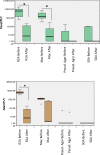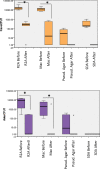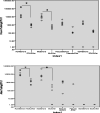Biofilm growth and microbial contamination of dental unit waterlines at Kuwait University dental center
- PMID: 36698450
- PMCID: PMC9868918
- DOI: 10.3389/froh.2022.1071018
Biofilm growth and microbial contamination of dental unit waterlines at Kuwait University dental center
Abstract
Biofilm formation in dental unit waterlines and the resulting microbial contamination of the water in the system has become a significant problem. Contaminated water in the dental units is a major concern in dental clinics due to potential risk of causing infections particularly in elderly and immunocompromised patients. The aim of this study was at first to determine microbial contamination of the dental unit waterlines and then to study the efficacy of a comprehensive disinfection protocol on decreasing the microbial load. Water samples were collected before and after disinfection procedure from handpieces and water storage bottles from the dental units, a small 1-cm tubing was cut from each unit and subjected to microbiological culture on different growth media. Identification of the predominant species was achieved by 16S rRNA gene sequencing. Microbial growth was observed in samples collected from all dental units. Upon disinfection procedure, microbial contamination in the water samples and in the tubing surfaces was significantly reduced (P > 0.05). 16S rRNA gene sequencing revealed the presence of several species belonging to the genera Staphylococcus, Corynebacterium and Roseomonas, some of which are implicated in human infections. Aggravation of the biofilm growth on the tubing surfaces and the microbial contamination in the water can be effectively controlled by implementing appropriate and routine disinfection protocols. This may help protect the dental unit staff and the patients being exposed to the risk of infections.
Keywords: 16S rRNA gene sequencing; biofilm; dental unit water line; microbial contamination; pathogenic species.
© 2023 Hussain Akbar, Behbehani and Karched.
Conflict of interest statement
The authors declare that the research was conducted in the absence of any commercial or financial relationships that could be construed as a potential conflict of interest.
Figures




Similar articles
-
[Effect of Using Hydrogen Peroxide for Periodic Disinfection Combined With Continuous Disinfection to Control Contamination in Dental Unit Waterline].Sichuan Da Xue Xue Bao Yi Xue Ban. 2024 Jan 20;55(1):217-223. doi: 10.12182/20240160210. Sichuan Da Xue Xue Bao Yi Xue Ban. 2024. PMID: 38322511 Free PMC article. Chinese.
-
The importance of biofilm contamination control for dental unit waterlines: a multicenter assessment of the microbiota diversity of biofilm in dental unit waterlines.J Oral Microbiol. 2023 Dec 30;16(1):2299496. doi: 10.1080/20002297.2023.2299496. eCollection 2024. J Oral Microbiol. 2023. PMID: 38174123 Free PMC article.
-
Dental unit waterlines: biofilms, disinfection and recurrence.J Am Dent Assoc. 1999 Jan;130(1):65-72. doi: 10.14219/jada.archive.1999.0030. J Am Dent Assoc. 1999. PMID: 9919033
-
Microbial Contamination of Dental Unit Waterlines and Potential Risk of Infection: A Narrative Review.Pathogens. 2020 Aug 13;9(8):651. doi: 10.3390/pathogens9080651. Pathogens. 2020. PMID: 32823641 Free PMC article. Review.
-
Microbial contamination of dental unit waterlines.Ann Agric Environ Med. 2008;15(2):173-9. Ann Agric Environ Med. 2008. PMID: 19061251 Review.
Cited by
-
UV-C side-emitting optical fiber-based disinfection: a promising approach for infection control in tight channels.Microbiol Spectr. 2024 Jun 4;12(6):e0004024. doi: 10.1128/spectrum.00040-24. Epub 2024 Apr 30. Microbiol Spectr. 2024. PMID: 38687120 Free PMC article.
-
Dental Unit Waterlines: Disinfection and Management.Int Dent J. 2024 Nov;74 Suppl 2(Suppl 2):S437-S445. doi: 10.1016/j.identj.2024.07.1269. Int Dent J. 2024. PMID: 39515931 Free PMC article. Review.
-
Mycobiology of Dental Unit Water: A Systematic Scoping Review.Int Dent J. 2025 Feb;75(1):86-99. doi: 10.1016/j.identj.2024.10.020. Epub 2024 Dec 18. Int Dent J. 2025. PMID: 39701921 Free PMC article.
-
Pyrosequencing analysis of bacterial community changes in dental unit waterlines after chlorogenic acid treatment.Front Cell Infect Microbiol. 2024 Jan 17;14:1303099. doi: 10.3389/fcimb.2024.1303099. eCollection 2024. Front Cell Infect Microbiol. 2024. PMID: 38299116 Free PMC article.
-
Legionella spp. in a Dental Office-Current State of Knowledge.Pathogens. 2025 May 22;14(6):512. doi: 10.3390/pathogens14060512. Pathogens. 2025. PMID: 40559520 Free PMC article. Review.
References
LinkOut - more resources
Full Text Sources
Molecular Biology Databases

